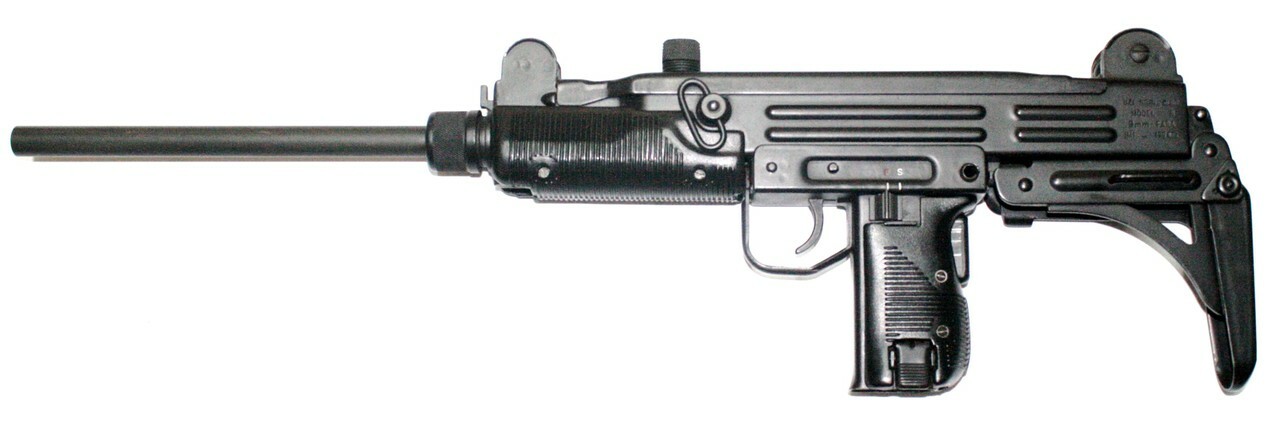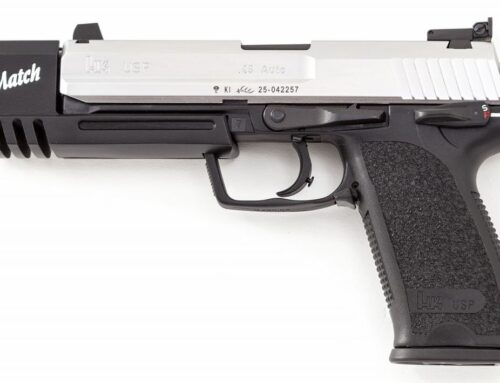This month the clock is being rewound all the way back to the 1950’s when an icon took shape in Israel. First issued in 1954 where it has seen countless use in action and an endless supply of action movies, I’m going to bring out some Schwarzenegger here and introduce: The Oozi nine millimeetah.
The IMI UZI has had such a huge stage presence in film and TV that I legitimately thought it was produced in the 1970’s. For a long time this was the go-to weapon for so many purposes, chances are if there was a scene which called for firearms there was an UZI somewhere in it. Feeding from straight “stick” magazines which fed into the grip, an UZI looked right at home as a massive pistol held in one hand as it did held in two hands while being unloaded from the hip. With a base weight not too far under eight pounds it certainly helps being an action movie star to throw one around, too.
Produced in massive numbers and in several calibers from .22LR to .45 ACP, the UZI had done so well that later offerings included a Mini-UZI and a Micro-UZI. Much like Ahnold it recently came back, the updated model from IWI called the UZI PRO. It’s the submachine gun which predated the HK MP5 and was famously seen being carried by a Secret Service agent back during the assassination attempt of President Regan in 1981.
Truly the UZI is one of the greats, another icon of legendary status which has made it from official service to Chuck Norris to comic book Deadpool. Though a lot has happened since the 1950’s and the firearms industry has changed in a lot of ways. How does this old workhorse hold up today? As someone who loves PCCs, sub guns and firearms history, this is one experience I am greatly looking forward to.
Admittedly, one of the first questions on my mind was “how well does it shoot one-handed?” Given that my example had to have been in the nine to ten pound range and firing from the hip tends to be frowned upon this posed quite the challenge. Once overcoming the obstacle of holding a full size 16″ barreled UZI at arm’s length, its mass and balance do a fantastic job of helping to keep it stable. While I only fired it twice this way the cycling of the bolt helped bring it back down on target quite nicely.
I’ve also learned that I am definitely not a T-800.
The mechanics behind the UZI are interesting and the semi-auto version more so. The core of the system is the telescoping bolt which I believe had been a fairly new concept at the time. Compared to Stens, Sterlings, M3 Grease Guns and MP40s which all had a heavy bolt sitting behind the barrel, the UZI goes around and over the top of the chamber area which is what gives it that nice balance and recoil.
The barrel situation is also really slick. There’s a separate threaded cap and ratcheting system up front which holds the barrel into the receiver. With this cap removed the barrel simply slides right out. It’s not only very easy to take down for cleaning but if you were to shoot out a barrel, or decide to turn one into a short barreled rifle, swapping it out takes mere seconds without any permanent modifications.
The barrel can also be changed out with, say, a vented heat shield like the one I reviewed has. I suspect this particular full length shroud with oval vents wasn’t a factory option as it doesn’t look like the most commonly pictured shorter type with round vents. Suppressor options which made use of the barrel nut setup also exist.
The traditional UZI uses what is called an open bolt design which means that charging the system leaves the chamber wide open with the entire bolt held up by the sear. This is a great design for an automatic weapon as it is easy to manufacture and helps with cooling the barrel and chamber. For the civilian market it had to be redone to fire from a closed bolt. How they converted its operation is quite nifty.
First, let’s discuss trigger pull. After some take-up of a rather thin trigger and hitting a wall there’s some mushiness before the sear breaks and here is where it feels really curious. Unlike a striker fired pistol where you’re releasing little more than a spring loaded firing pin there’s a certain “meatiness” to the UZI. A feeling of something substantial happening. To be honest it’s a rather satisfying feeling, the pull is a bit heavy but it comes with its own reward. Trigger reset is on the lengthy side but it’s solid with both an audible and tactile feel.
The source for this trigger pulling drama comes under the hood. First the top cover needs to be popped off which is started with a spring loaded button at the front of the rear sight base. With the cover removed the bolt can be drawn back slightly with your fingers then lifted up and out of the receiver. Here’s where the UZI gets you if you don’t know what to expect.
Unlike the open bolt UZIs which have a bolt, recoil spring and guide rod, the closed bolt has two pieces and two springs and the lower piece doesn’t like to lift out with the upper piece. What happens is when chambered the bolt itself goes forward but a hefty L-shaped bracket remains behind. The bolt was effectively separated into two pieces, each with their own spring. When you pull the trigger there’s a substantial chunk of steel rocketing forward, fixed firing pin and all. In a sense it almost mimics the open bolt feeling but to a lesser degree, I’ve never felt another trigger like it.
Controls are kept simple with the magazine release being a tab on the bottom left of the grip, it’s quite easy to push the tab with your left thumb while holding and withdrawing the mag. The safety is a sliding switch positioned by the thumb which easily slides forward to fire. The example I had was stiff going back to safe. By far what bothered me the most is the grip safety. While I generally don’t mind these safeties, the one on the UZI was very stiff and uncomfortable between having constant pressure in the web of the hand and the rough outer edges of the polymer grip.
The folding stock is surprisingly well designed and much more stable then I would have given it credit for with two hinges and stamped sheet steel, there was only a small amount of vertical play. I haven’t mastered its operation but the second hinge takes a little pinch to unlock then the whole assembly can be snapped open or hooked closed where it secures into a lug at the bottom of the receiver. As can be expected, shooting with an under-folding metal stock isn’t terribly fun though it does add to the iconic UZI look. Fixed wooden stocks are also an option.
The sights are a front post and rear aperture and provide a decent picture. At fifty feet I felt the accuracy was quite good although the gun’s weight quickly got in the way of a stable hold. Actually shooting the UZI was an enjoyable experience and getting to fire one makes you feel like the coolest person on the range, these guns are uncommon and simply look amazing.
Accessorizing an UZI can be tricky but it is possible. Various scope mounts exist and I have seen pictures of a forend with a vertical grip which imitates the rear grip quite nicely. While not the best options they do help provide a little room for upgrades.
Compared to modern PCCs it’s difficult to say that the UZI has a place among them. It’s far heavier, clunkier, doesn’t have the best trigger or ergonomics, has very limited support for upgrades or accessories, and can be difficult to wring out its full potential. But, let’s be real. You don’t own an UZI for high speed competitive shooting. You own one because it’s a classic which has been reliably chugging along for nearly seventy years. They’re cool, quirky, and memorable and I can’t help but get a little giddy whenever I see one (which has happened exactly three times now.)
The UZI is one for enthusiasts and collectors. If you’re looking for something “a little different” to take out and regularly shoot then I would say better options exist. Although with a full size UZI you just might save some ammo because your arms will be too tired to keep shooting it.








